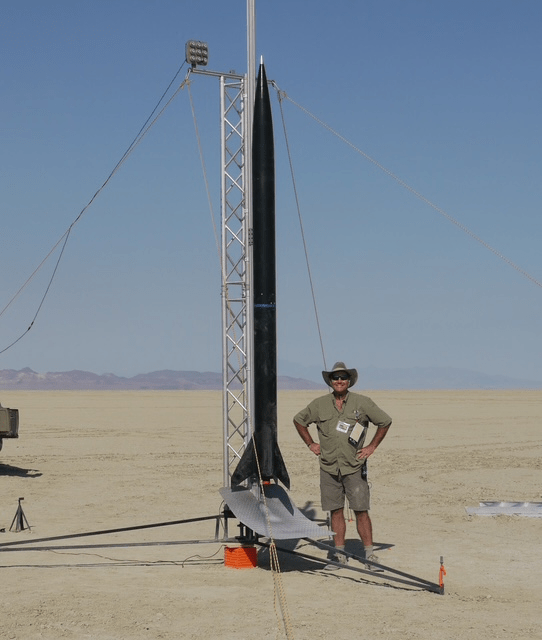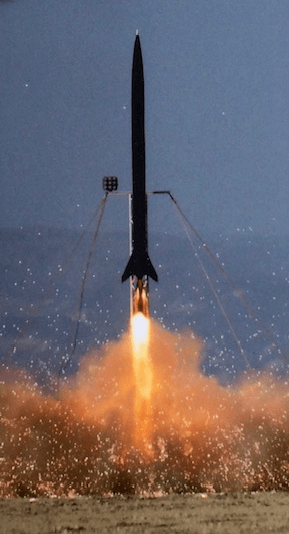Ray Shepard is what’s typically called a born again rocketeer. When he was a kid, Ray built and launched Estes rockets in the pasture next to his house. He always enjoyed it, but as is with most childhood hobbies, Ray lost interest somewhere along the way.

Fast forward to later in life… Ray was working a stressful job and thought finding a hobby would be a way to relax a little. With a large field next to his house, and a lot of kids in my neighborhood, he thought building some rockets might be fun.
A quick Internet search landed Ray on the Public Missiles website. He was amazed at what was currently available for adults. He purchased a kit, but soon realized he needed bigger equipment from what he had to launch it. With a little more research he discovered the Dallas Area Rocket Society (DARS) and attended one of their monthly meetings. There he met some great people who not only mentored, but also inspired him.
As Ray’s skills developed, his interest leaned more to high power rocketry, which led to his association with the local Tripoli Rocketry Association affiliated club which is where he now call home.
Ray has been a member of Tripoli North Texas (TNT) for around 12 years, serving as president of the organization for the last 5 years.
Ron Hervey: First of all, thank you so much for agreeing to do this interview. Tell me about Tripoli North Texas (TNT).
Ray Shepard: I could not be more excited to tell you about TNT and the long history of our club. We are Prefecture number 58 and this is the 35th anniversary of our club. We have a long history in the DFW area, and our membership legacy is comprised of some of the top rocketeers in the country.
About 5 years ago, several members of the club and I began a complete overhaul of the club, and it has been an amazing journey. We have rebuilt our web and social media space which has driven awareness and club membership to an all-time high. We currently have approximately 150 members. This makes us one of the largest and fastest growing clubs in the country.
The influx of new members has allowed us to develop our launch infrastructure to top standards. We have a beautiful launch site about 3 hours west of Dallas in Seymour, Texas. This site boasts the highest altitude club waiver in the state at 45,000 feet. We have a state-of-the-art wireless launch control system and excellent quality launch pads that service all size rockets. Our largest pad, named Big TEX, is a 24-foot tall, hydraulically operated tower pad capable of launching rockets weighing in excess of 200 pounds.
However, what I am most proud of is our members. We have a tremendous number of level 3 fliers, but new members with little to no experience in rocketry will feel just as welcome as experienced fliers. We operate as a community where everyone, regardless of their skill level, is constantly learning and helping others develop. Our site has become a favorite with collegiate rocketry programs around the state and beyond. Our high waiver gives the teams a venue to test their most advanced and complex projects in a safe environment and access an extensive knowledge base of our senior level flyers.
As I mentioned, we are a Prefecture of the Tripoli Rocketry Association. Membership fees for our local club are $40 a year for adults and $10 for junior or student members.

RH: What are the differences between a club associated with the Tripoli Rocketry Association such as TNT and a National Association of Rocketry affiliated club?
RS: Amazingly, there are more similarities between Tripoli and NAR than there are differences. Both organizations are highly focused on safety for our members and all who attend our launches. To this end, both organizations require proficiency exams, or certifications, for members wishing to launch larger and more complex rockets. Additionally, both national organizations provide an insurance policy to each of its members which covers them when they are launching with an affiliated club. A national membership with Tripoli or NAR is a requirement to launch with TNT.
RH: How many launches does TNT sponsor a year?
RS: TNT currently hosts 5 launches a year, all are a minimum of 2 days long. Our launches are normally the 4th weekend of the month beginning in January and continuing though May.
We have two special launches during the season. First, the March launch is combined with a college team competition called “The Lone Star Cup”. In 2024, we hosted 13 teams and over 200 college students.
The second is in May and it is called “The Texas Shootout”. For the Shootout, we invite all the clubs in Texas and surrounding states to join us in Seymour over the Memorial Day weekend. This is a three-day event combines flying with evening meals and great camaraderie.
RH: Tell me about a TNT launch.
RS: No memberships are required to attend our launches. Spectators are welcome. We do ask that anyone attending as a spectator or flyer go to our Tripoli North Texas website and register in advance of the launch. This is a very easy process and only takes a few minutes.
On our website we also have maps of the area, options for local lodging if you wish to stay overnight, associated fees, and all the details you will need about the field and associated amenities.
RH: What is the average attendance at a launch?
RS: Our normal attendance can range from 50 to over 200, depending on the event.
RH: For someone just getting into rocketry, what is your best advice?
RS: My best advice would be to find a local club with members you are comfortable with. Nothing will help you get your bearings like seeing other projects and discussing the best building techniques, motor choices and recovery options with experienced flyers.
RH: What are your recommendations of a rocket kit for someone just stepping up to high power?
RS: Depending on your budget, I’m a big fan of LOC Precision and PML. I like them because they have step by step instructions and a lot of their kits come complete with shock cords and parachutes. For more advanced fiberglass rockets, I personally like Wildman Rocketry kits.
RH: Tell me about the high power certification process with Tripoli Rocketry Association.
RS: Tripoli offers three levels of certification. Level 1 certification requires you to build, successfully shoot and recover a rocket with an H or I impulse motor.
Level 2 certification requires the passing of a written exam and successfully building, shooting and recovery of a rocket with a J, K or L impulse motor.
Level 3 certification is the most complex. It requires the involvement of 2 especially skilled members called TAP’s that will review your design specification, inspect your construction process, and witness your flight on a motor with a M or greater impulse.
RH: Tell me about some of the rockets that you have built and how they have done.
RS: Over the past 15 years, I have built a lot of rockets, both big and small. My favorite project was a Jumbo Jart. It was a 6-inch rocket that was 19 feet tall and weighed 99 pounds on the pad. I flew it at the BALLS launch in the Black Rock Desert, one week after the Burning Man festival. I had a great flight on an N3400 sparky motor to almost 20,000 feet!
RH: In your opinion, what is the future of rocketry?
RS: The sky is the Limit!
RH: Thank you so very much for your time and cooperation. I look forward to seeing you at a TNT launch sometime in the future.
Check out more info on rocketry on my Knowledge Base page.
